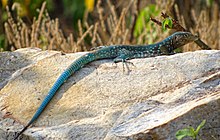Cnemidophorus
This article needs additional citations for verification. (January 2014) |
| Cnemidophorus | |
|---|---|

| |
| Aruban Whiptail Cnemidophorus arubensis | |
| Scientific classification | |
| Domain: | Eukaryota |
| Kingdom: | Animalia |
| Phylum: | Chordata |
| Class: | Reptilia |
| Order: | Squamata |
| Family: | Teiidae |
| Subfamily: | Teiinae |
| Genus: | Cnemidophorus Wagler, 1830[1] |
Cnemidophorus is a genus of lizards in the family Teiidae. Species in the genus Cnemidophorus are commonly referred to as whiptail lizards or racerunners. Note that the Reeder et al. (2002) re-examined the nomenclature for this genus and split it into the two genera Aspidoscelis and Cnemidophorus.
The name Cnemidophorus literally means "greave-wearing", from the Ancient Greek knēmido- (combining form of knēmis, "greave", a leg armor) and -phoros ("bearer").[2]
Reproduction
In some of the Cnemidophorus species, there are no males, and they reproduce through parthenogenesis. This is well known in bees and aphids, but is very rare in vertebrates. Those species without males are now known to originate through hybridization, or interspecific breeding. Occasionally, a mating between a female of one species and a male of another produces a parthenogen, a female that is able to produce viable eggs that are genetically identical to her own cells. The lizards that hatch from these eggs are thus also parthenogens that can again produce identical eggs, resulting in an asexual, clonal population. Parthenogenetic species resulting from a single hybridization are diploid (that is, they have two sets of chromosomes just as sexual species do), but sometimes these females mate with other males, producing offspring which are triploid (that is, they have three sets of chromosomes, or 50% more than equivalent sexual species; see polyploidy). Over 30% of the Cnemidophorus genus are parthenogenic.
Species
The genus Cnemidophorus, sensu lato, contains the following species.
- Cnemidophorus angusticeps
- Cnemidophorus arenivagus
- Cnemidophorus arizonae
- Cnemidophorus arubensis
- Cnemidophorus burti
- Cnemidophorus calidipes
- Cnemidophorus ceralbensis
- Cnemidophorus communis
- Cnemidophorus costatus
- Cnemidophorus cozumelae
- Cnemidophorus cryptus
- Cnemidophorus deppei
- Cnemidophorus dixoni
- Cnemidophorus exsanguis
- Cnemidophorus flagellicaudus
- Cnemidophorus gramivagus
- Cnemidophorus gularis
- Cnemidophorus guttatus
- Cnemidophorus gypsi
- Cnemidophorus inornatus
- Cnemidophorus labialis
- Cnemidophorus lacertoides
- Cnemidophorus laredoensis
- Cnemidophorus leachei
- Cnemidophorus lemniscatus
- Cnemidophorus lineattissimus
- Cnemidophorus littoralis
- Cnemidophorus longicaudus
- Cnemidophorus marmoratus
- Cnemidophorus martyris
- Cnemidophorus maximus
- Cnemidophorus mexicanus
- Cnemidophorus motaguae
- Cnemidophorus mumbuca
- Cnemidophorus murinus
- Cnemidophorus nativo
- Cnemidophorus neomexicanus
- Cnemidophorus neotesselatus
- Cnemidophorus nigricolor
- Cnemidophorus ocellifer
- Cnemidophorus opatae
- Cnemidophorus parecis
- Cnemidophorus parvisocius
- Cnemidophorus pseudolemniscatus
- Cnemidophorus rodecki
- Cnemidophorus sackii
- Cnemidophorus scalaris
- Cnemidophorus septemvittatus
- Cnemidophorus serranus
- Cnemidophorus sonorae
- Cnemidophorus tesselatus
- Cnemidophorus vacariensis
- Cnemidophorus vanzoi
- Cnemidophorus velox
See also
References
3. “Western Whiptail Lizard.” Whiptail Lizard - Desert Wildlife, digital-desert.com/wildlife/whiptail-lizard.html
Further reading
- Wagler J. 1830. Natürliches System der AMPHIBIEN, mit vorangehender Classification der SÄUGTHIERE und VÖGEL. Ein Beitrag zur vergleichenden Zoologie. Munich, Stuttgart and Tübingen: J.G. Cotta. vi + 354 pp. + one plate. (Cnemidophorus, new genus, p. 154). (in German and Latin).
External links
- Cnemidophorus deppei and other lizards of Laguna de Apoyo Nature Reserve, Nicaragua
- Reeder, Tod W.; Dessauer, Herbert C.; Cole, Charles J. (2002). Phylogenetic relationships of whiptail lizards of the genus Cnemidophorus (Squamata, Teiidae): a test of monophyly, reevaluation of karyotypic evolution, and review of hybrid origins. American Museum Novitates (3365): 1-61. [1]
